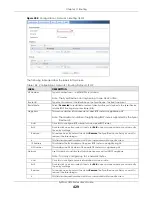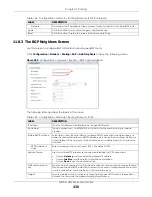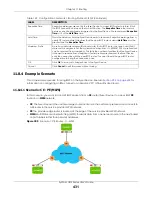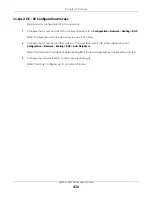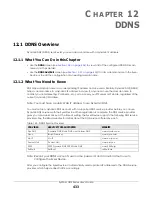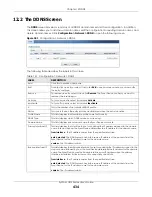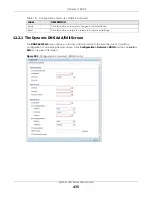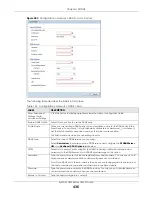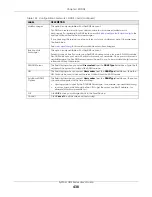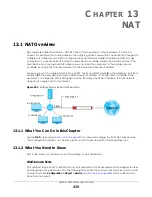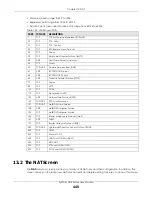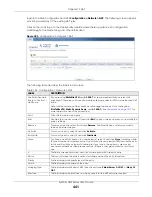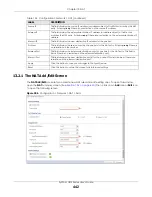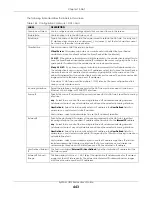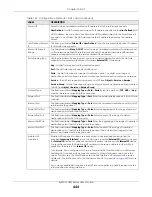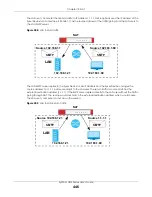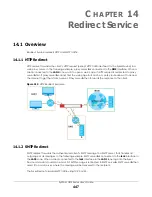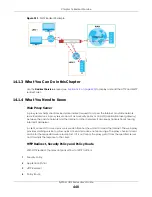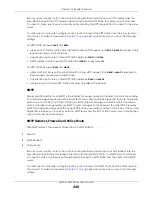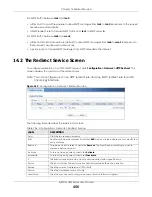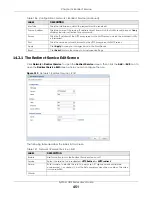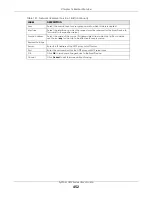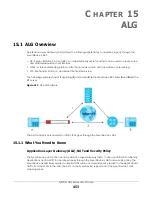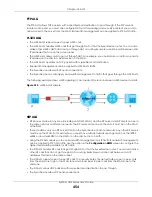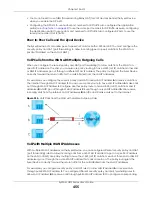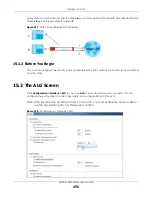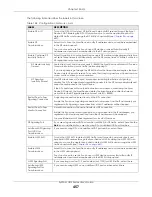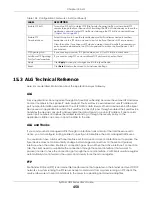
Chapter 13 NAT
ZyWALL USG Series User’s Guide
443
The following table describes the labels in this screen.
Table 155 Configuration > Network > NAT > Add
LABEL
DESCRIPTION
Create new Object
Use to configure any new settings objects that you need to use in this screen.
Enable Rule
Use this option to turn the NAT rule on or off.
Rule Name
Type in the name of the NAT rule. The name is used to refer to the NAT rule. You may use 1-
31 alphanumeric characters, underscores(
_
), or dashes (-), but the first character cannot
be a number. This value is case-sensitive.
Classification
Select what kind of NAT this rule is to perform.
Virtual Server
- This makes computers on a private network behind the Zyxel Device
available to a public network outside the Zyxel Device (like the Internet).
1:1 NAT
- If the private network server will initiate sessions to the outside clients, select this to
have the Zyxel Device translate the source IP address of the server’s outgoing traffic to the
same public IP address that the outside clients use to access the server.
Many 1:1 NAT -
If you have a range of private network servers that will initiate sessions to
the outside clients and a range of public IP addresses, select this to have the Zyxel Device
translate the source IP address of each server’s outgoing traffic to the same one of the
public IP addresses that the outside clients use to access the server. The private and public
ranges must have the same number of IP addresses.
One many 1:1 NAT rule works like multiple 1:1 NAT rules, but it eases configuration effort
since you only create one rule.
Incoming Interface
Select the interface on which packets for the NAT rule must be received. It can be an
Ethernet, VLAN, bridge, or PPPoE/PPTP interface.
Source IP
Specify the source IP address of the packets received by this NAT rule’s specified incoming
interface.
any
- Select this to use all of the incoming interface’s IP addresses including dynamic
addresses or those of any virtual interfaces built upon the selected incoming interface.
User Defined
- Select this to manually enter an IP address in the
User Defined
field. For
example, you could enter a static IP address.
Host address - select a address object to use the IP address it specifies.
External IP
Specify the destination IP address of the packets received by this NAT rule’s specified
incoming interface. The specified IP address will be translated to the
Internal IP
address.
any
- Select this to use all of the incoming interface’s IP addresses including dynamic
addresses or those of any virtual interfaces built upon the selected incoming interface.
User Defined
- Select this to manually enter an IP address in the
User Defined
field. For
example, you could enter a static public IP assigned by the ISP without having to create a
virtual interface for it.
Host address - select a host address object to use the IP address it specifies. The list also
includes address objects based on interface IPs. So for example you could select an
address object based on a WAN interface even if it has a dynamic IP address.
User Defined External
IP
This field is available if
External IP
is
User Defined
. Type the destination IP address that this
NAT rule supports.
External IP Subnet/
Range
This field displays for Many 1:1 NAT. Select the destination IP address subnet or IP address
range that this NAT rule supports. The external and internal IP address subnets or ranges
must have the same number of IP addresses.
Summary of Contents for USG110
Page 27: ...27 PART I User s Guide ...
Page 195: ...195 PART II Technical Reference ...
Page 309: ...Chapter 10 Interfaces ZyWALL USG Series User s Guide 309 ...
Page 313: ...Chapter 10 Interfaces ZyWALL USG Series User s Guide 313 ...
Page 358: ...Chapter 10 Interfaces ZyWALL USG Series User s Guide 358 ...
Page 373: ...Chapter 10 Interfaces ZyWALL USG Series User s Guide 373 ...

